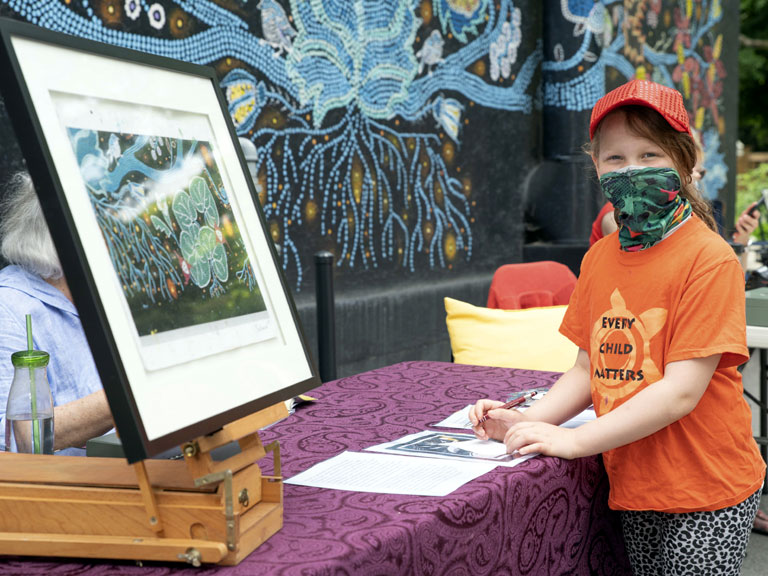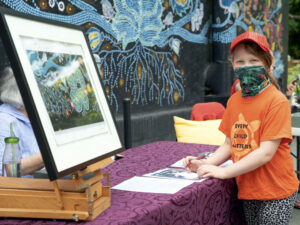County News
A call to action

A day of reflection, conversation and education
This year’s colour for Canada Day was orange rather than the traditional red and white. The discovery of now more than a thousand unmarked graves at or near the sites of residential schools prompted calls for a cancellation of the usual Canada Day celebrations, and instead to focus on the treatment of Indigenous peoples by a long succession of governments, including the present one. After the discovery of the first 215 unmarked graves at a residential school in Kamloops, an orange T-shirt came to symbolize missing and mistreated students who were taken from their families and forced to attend these schools. While thinking about this, Reverend Lynne Donovan of the St. Andrew’s Presbyterian Church in Picton came up with the idea of gathering a group of people to knit small orange sweaters against the backdrop of artist Christi Belcourt’s Wisdom of the Universe mural as an acknowledgment of the grief felt by many Canadians. Rev. Donovan soon recognized that there needed to be something more than addressing grief in order to move forward. “It seemed important to host an event that would involve both awareness and action. If we cannot have the hard conversations together about the truth of Canada’s history, we cannot participate in a new story,” she said. So in addition to the knitting circle, on July 1 she set up four additional stations in the church parking lot where visitors could learn about the injustices perpetrated by the Indian Act, have an opportunity to sign a letter to MP Neil Ellis calling for improvements to housing and the provision of clean drinking water on reserves, make a donation to an organization that fosters Indigenous education, and buy some fry bread made by Tyendinaga resident Mary Maracle, with proceeds going to the Tyendinaga Seed Sanctuary. Over 150 people attended the event, and about $3,500 was raised to support Indigenous initiatives. “It was very exciting for me to see over a dozen people in a circle knitting, or learning to knit, and being aware of the conversations taking place in the circle,” she said. “It was interesting that people who came to one of the tables that I was manning, and these were educated white people, who knew nothing about our history or the history of residential schools. There are no easy answers, particularly when you have so many members of Indigenous communities still trying to recover from trauma. So how do we begin to address the trauma that was created because of racism that was written into our Constitution? Education, awareness, grace, generosity and understanding—all of those things are steps in the right direction.”

Aubrey Kelly fills in a ballot for the draw prize of a framed print of a section of Métis artist Christi Belcourt’s Wisdom of the Universe mural.
Kelsey Howe brought her three young children to the event, to help to teach them a little about the history of Canada. “This was all fairly new information for them. They’ve had a little bit of exposure over the last couple of years, and we’ve introduced them to this history that hasn’t been really well documented,” she said. “The new information that has been coming out is very shocking and has given them a perspective on what has been happening. It’s really hard for kids to conceptualize. I’ve been able to get a couple of books from County Reads. They did a really great job setting up a section of books that were all children-specific and deal with the idea of residential schools at a kid level. I feel like Canada Day should still be celebrated, and I think we should still feel proud to be a country together. We need to take a moment to remember just what a history we have had and not push it under the rug any longer.”
One of the people who had direct knowledge of residential schools was Rick Byce. His father, Charles, was sent to a residential school in Northern Ontario. He survived his time there and went on to become Canada’s highest decorated soldier in World War Two, receiving his medal from King George VI in Buckingham Palace. Rick’s grandfather served in the First World War and was awarded the same medal, and their story is on display at the War Museum in Ottawa. Rick told a story about how his grandmother was forbidden from visiting her children in the residential school, which she could see from across the river where she lived. Charles at the time was five years old, and he was being cared for by his older brother Alan, 12. Time at the residential school, as well as his war experience, took a toll on Charles. “I can still see him sometimes, when I would come home when I was older, and I could look in through the window and see my father crying,” said Rick. “We’ve been on this land for over 10,000 years, but the land and everything was taken away from us. They took our children and put them in residential schools and they were physically, mentally, emotionally and sexually abused. Nobody knew that story. We knew it. The stories are coming out. The parents never knew their children died. They never came back home. They were just thrown in the dirt. We had that happen to children from our reserve too.” As a child, Rick did not learn about his Indigenous heritage, and he said that discrimination by white residents was always present. “I was never allowed in people’s homes. It wasn’t my friends, the young people I grew up with, it was their parents. I had to stand outside and wait. I would be chased out of their yards.” It was only in his adulthood that Rick began to learn about his culture and his spirituality. In 2016, when a statue of his father was unveiled at the Legion in Chapleau, Rick found a stick on the grounds where a residential school once stood and carved it in memory of his dad. At the head of the stick is the figure of the Warrior and the Thunderbird; at the bottom of the stick is the winding Red Road that leads to everlasting peace in the afterlife.

Comments (0)